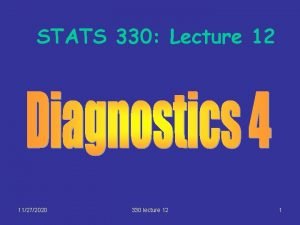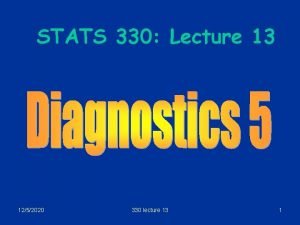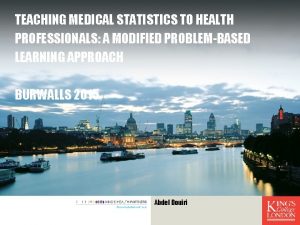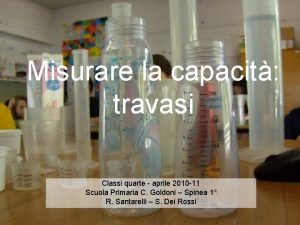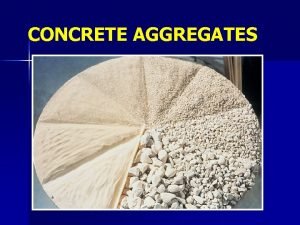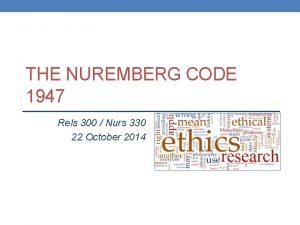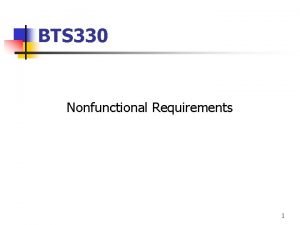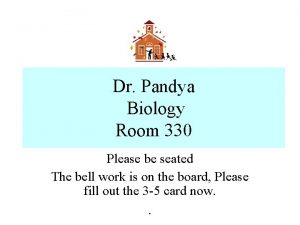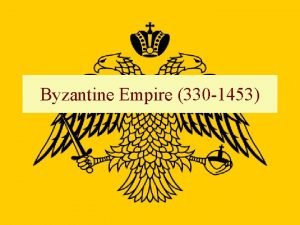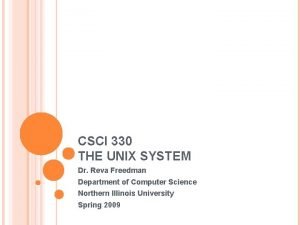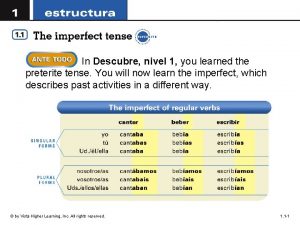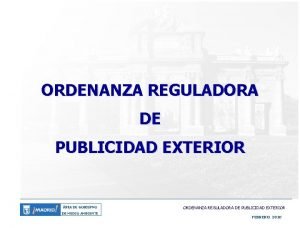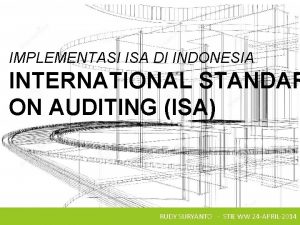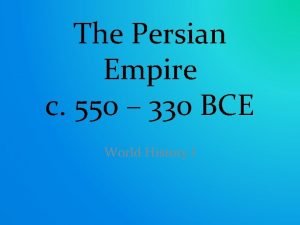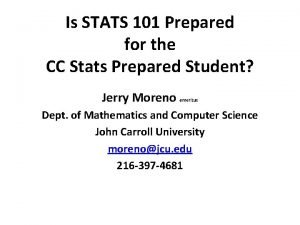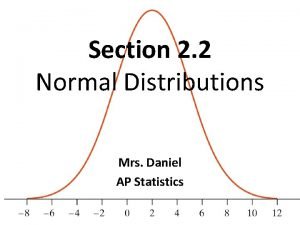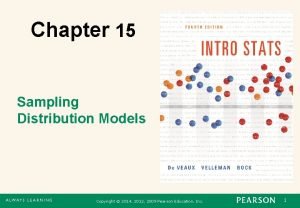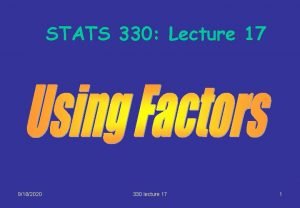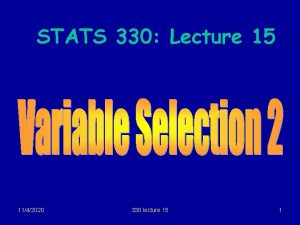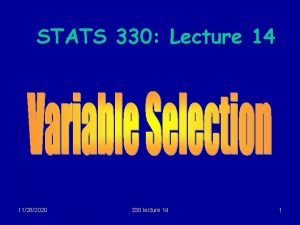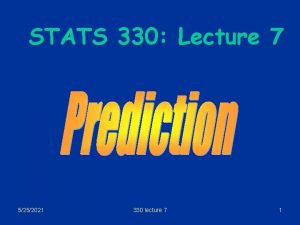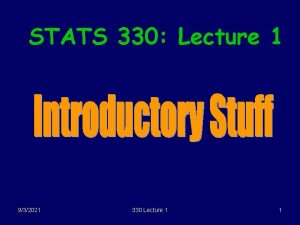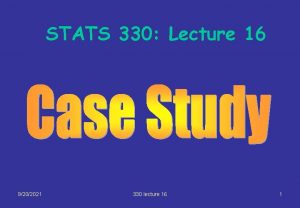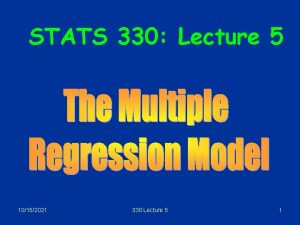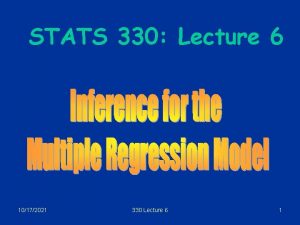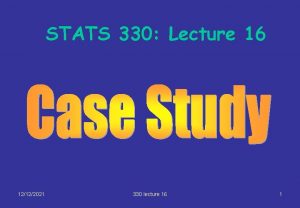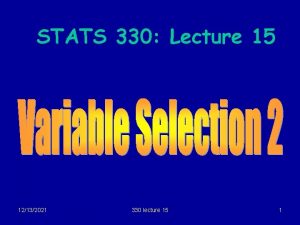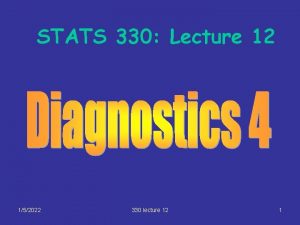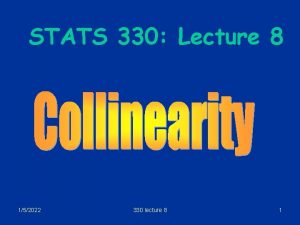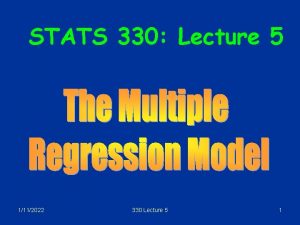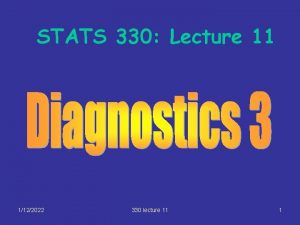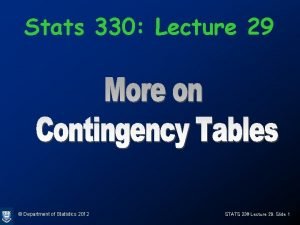Stats 330 Lecture 28 Department of Statistics 2012

























![The analysis > housing. glm<-glm(count~sat*infl*cont, family=poisson, data=housing. df) > anova(housing. glm, test]”Chisq”) Df Deviance The analysis > housing. glm<-glm(count~sat*infl*cont, family=poisson, data=housing. df) > anova(housing. glm, test]”Chisq”) Df Deviance](https://slidetodoc.com/presentation_image/41b79c1a85481b8b9379994ee771c176/image-26.jpg)




![Estimating conditional OR for housing data (2) > 0. 4157+c(-1, 1)*1. 96*0. 1948 [1] Estimating conditional OR for housing data (2) > 0. 4157+c(-1, 1)*1. 96*0. 1948 [1]](https://slidetodoc.com/presentation_image/41b79c1a85481b8b9379994ee771c176/image-31.jpg)




![Examples • 2 factor model A + B + A: B or [AB] A Examples • 2 factor model A + B + A: B or [AB] A](https://slidetodoc.com/presentation_image/41b79c1a85481b8b9379994ee771c176/image-36.jpg)



- Slides: 39

Stats 330: Lecture 28 © Department of Statistics 2012 STATS 330 Lecture 28: Slide 1

Plan of the day In today’s lecture we apply Poisson regression to the analysis of contingency tables having 3 or 4 dimensions. Topics – Types of independence – Connection between independence and interactions for 3 and 4 dimensional tables – Hierarchical models – Graphical models – Examples Reference: Coursebook, sections 5. 3, 5. 3. 1 © Department of Statistics 2012 STATS 330 Lecture 28: Slide 2

Example: the Florida murder data • 326 convicted murderers in Florida, 19761977 • Classified by – Death penalty (n/y) – Victims race (black/white) – Defendants race (black/white) © Department of Statistics 2012 STATS 330 Lecture 28: Slide 3

Contingency table Victim's race Defendant's Race Black White Death Penalty Yes No Black 13 195 23 105 White 1 19 39 265 © Department of Statistics 2012 STATS 330 Lecture 28: Slide 4

Getting the data into R murder. df<-data. frame(expand. grid( defendant=c("b", "w"), dp = c("y", "n"), victim=c("b", "w")), counts=c(13, 1, 195, 19, 23, 39, 105, 265)) Note use of function expand. grid(defendant=c("b", "w"), dp = c("y", "n"), victim=c("b", "w")) defendant dp victim 1 2 3 4 5 6 7 8 b w b w © Department of Statistics 2012 y y n n b b w w STATS 330 Lecture 28: Slide 5

The data frame 1 2 3 4 5 6 7 8 defendant b w b w © Department of Statistics 2012 dp victim counts y b 13 y b 1 n b 195 n b 19 y w 23 y w 39 n w 105 n w 265 STATS 330 Lecture 28: Slide 6

Questions • Is death penalty independent of race? • What is the role of victim’s race? • What does “independent” mean when we have 3 factors? © Department of Statistics 2012 STATS 330 Lecture 28: Slide 7

Types of independence • Suppose we have 3 criteria (factors) A, B and C • In a multinomial sampling context, let pijk = Pr(A=i, B=j, C=k) • Various forms of independence may be of interest. These can be expressed in terms of the probabilities pijk © Department of Statistics 2012 STATS 330 Lecture 28: Slide 8

Marginal probabilities © Department of Statistics 2012 STATS 330 Lecture 28: Slide 9

Marginal probabilities (ii) © Department of Statistics 2012 STATS 330 Lecture 28: Slide 10

All three factors independent • This can be expressed as © Department of Statistics 2012 STATS 330 Lecture 28: Slide 11

One factor independent of the other two • This can be expressed as © Department of Statistics 2012 STATS 330 Lecture 28: Slide 12

Two factors conditionally independent, given a third This can be expressed as © Department of Statistics 2012 STATS 330 Lecture 28: Slide 13

Parameterising tables of Poisson means with main effects and interactions • Recall (see Slides 22 and 23 of lecture 19) that in ordinary 3 -way ANOVA we split up the table of means into main effects and interactions: mijk = m + ai + bj + gk + (ab)ij + (bg)jk + (ag)ik +(abg)ijk • We can do exactly the same thing with the logs of the Poission means in a 3 -way table: Log(mijk) = m + ai + bj + gk + (ab)ij + (bg)jk + (ag)ik +(abg)ijk © Department of Statistics 2012 STATS 330 Lecture 28: Slide 14

Parameterising tables of probabilities with main effects and interactions • Corresponding multinomial probabilities are given by the model Log(pijk / p 111) = ai + bj + gk + (ab)ij + (bg)jk + (ag)ik +(abg)ijk © Department of Statistics 2012 STATS 330 Lecture 28: Slide 15

Parameterising tables with main effects and interactions (cont) • The interactions are related to the different forms of independence: – if all the interactions are zero, then the 3 factors are mutually independent – If the ABC and AB interactions are zero, then A and B are independent, given C – If the ABC, AB and AC interactions are zero, then A is independent of B and C • Using the connection between multinomial and Poisson sampling, we can test for the various types of independence by fitting a Poisson regression with A, B and C as explanatory variables, and testing for interactions. © Department of Statistics 2012 STATS 330 Lecture 28: Slide 16

Summary of independence models • All 3 factors independent in multinomial model – Equivalent to all interactions zero in Poisson model – Poisson Model is count ~ A + B + C • A independent of B and C – Equivalent to all interactions between A and the others zero – Poisson Model is count ~ A + B + C + B: C or count ~ A + B*C © Department of Statistics 2012 STATS 330 Lecture 28: Slide 17

Summary of independence models (cont) • Factors A and B conditionally independent given C – Equivalent to all interactions containing both A and B zero – Poisson Model is count ~ A + B + C + A: C + B: C – Equivalent to count ~ A*C + B*C © Department of Statistics 2012 STATS 330 Lecture 28: Slide 18

Analysis strategy: Florida data • We will fit some models to this data and investigate the pattern of independence/ dependence between the factors. • We fit a maximal model, and then investigate suitable submodels. © Department of Statistics 2012 STATS 330 Lecture 28: Slide 19

The analysis > maximal. glm<-glm(counts~victim*defendent*dp, family=poisson, data=murder. df) > anova(maximal. glm, test="Chisq") Df Deviance Resid. Df Resid. Dev P(>|Chi|) NULL 7 774. 73 victim 1 64. 10 6 710. 63 1. 183 e-15 defendent 1 0. 22 5 710. 42 0. 64 dp 1 443. 51 4 266. 90 1. 861 e-98 victim: defendent 1 254. 15 3 12. 75 3. 230 e-57 victim: dp 1 10. 83 2 1. 92 9. 999 e-04 defendent: dp 1 1. 90 1 0. 02 0. 17 victim: defendent: dp 1 0. 02 0 -2. 442 e-15 0. 89 > No interactions between defendants race and death penalty - Seems that model victim*dp + victim*defendant is appropriate “given the victim’s race, defendants race and death penalty are independent” ie the conditional independence model. Model also selected by stepwise, other anovas. © Department of Statistics 2012 STATS 330 Lecture 28: Slide 20

Testing if the model is adequate submodel. glm<-glm(counts~victim*defendant + victim*dp, family=poisson, data=murder. df) > summary(submodel. glm) Deviance Residuals: 1 2 3 4 5 6 7 8 0. 0636 -0. 2127 -0. 0163 0. 0525 1. 0389 -0. 7138 -0. 4453 0. 2860 Coefficients: Estimate Std. Error z value Pr(>|z|) (Intercept) 2. 5472 0. 2680 9. 503 < 2 e-16 *** victimw 0. 3635 0. 3057 1. 189 0. 23449 defendantw -2. 3418 0. 2341 -10. 003 < 2 e-16 *** dpn 2. 7269 0. 2759 9. 885 < 2 e-16 *** victimw: defendantw 3. 2068 0. 2567 12. 491 < 2 e-16 *** victimw: dpn -0. 9406 0. 3081 -3. 053 0. 00227 ** > • --- © Department of Statistics 2012 STATS 330 Lecture 28: Slide 21

Testing if the model is adequate Null deviance: 774. 7325 on 7 degrees of freedom Residual deviance: 1. 9216 on 2 degrees of freedom AIC: 56. 638 Number of Fisher Scoring iterations: 4 > 1 -pchisq(1. 9216, 2) [1] 0. 3825867 Model seems OK © Department of Statistics 2012 Some hint cell 8 not well fitted STATS 330 Lecture 28: Slide 22

Example: the Copenhagen housing data • 317 apartment residents in Copenhagen were surveyed on their housing. 3 variables were measured: – sat: satisfaction with housing (Low, medium, high) – cont: amount of contact with other residents (Low, high) – infl: influence on management decisions – (Low, medium, high) © Department of Statistics 2012 STATS 330 Lecture 28: Slide 23

Copenhagen housing data sat infl Low Medium Low High Low Medium High Medium Low High Medium High 9 more lines… © Department of Statistics 2012 cont count Low 61 Low 23 Low 17 Low 43 Low 35 Low 40 Low 26 Low 18 Low 54 STATS 330 Lecture 28: Slide 24

Copenhagen housing data infl = Low Low 61 sat Medium High infl = Med cont 78 Low 43 48 23 46 sat Medium 35 45 17 43 High 40 86 Low High cont Low High infl = High © Department of Statistics 2012 cont Low 26 15 sat Medium 18 25 High 54 62 Low High STATS 330 Lecture 28: Slide 25
![The analysis housing glmglmcountsatinflcont familypoisson datahousing df anovahousing glm testChisq Df Deviance The analysis > housing. glm<-glm(count~sat*infl*cont, family=poisson, data=housing. df) > anova(housing. glm, test]”Chisq”) Df Deviance](https://slidetodoc.com/presentation_image/41b79c1a85481b8b9379994ee771c176/image-26.jpg)
The analysis > housing. glm<-glm(count~sat*infl*cont, family=poisson, data=housing. df) > anova(housing. glm, test]”Chisq”) Df Deviance Resid. Df Resid. Dev P(>|Chi|) NULL 17 166. 757 sat 2 26. 191 15 140. 566 2. 054 e-06 infl 2 20. 040 13 120. 526 4. 451 e-05 cont 1 22. 544 12 97. 983 2. 054 e-06 sat: infl 4 75. 577 8 22. 406 1. 504 e-15 sat: cont 2 7. 745 6 14. 661 0. 021 infl: cont 2 11. 986 4 2. 675 0. 002 sat: infl: cont 4 2. 675 0 9. 546 e-15 0. 614 This time, only the 3 -factor interaction is insignificant. This is the “homogeneous association model” © Department of Statistics 2012 STATS 330 Lecture 28: Slide 26

Homogeneous association model • Association between two factors measured by sets of odds ratios © Department of Statistics 2012 STATS 330 Lecture 28: Slide 27

Copenhagen housing OR’s infl = Low infl = Med cont Low High Low * * sat Medium * 1. 56 sat Medium * 1. 15 High * 1. 97 High * 1. 92 infl = High © Department of Statistics 2012 cont Low * * sat Medium * 2. 40 High * 1. 99 Low High 26 15 18 25 54 62 26*25/(18*15) 26*62/(54*15) STATS 330 Lecture 28: Slide 28

Homogeneous association model (2) • For the homogeneous association model, the conditional odds ratios for A and B (ie using the conditional distributions of A and B given C=k) do not depend on k. That is, the pattern of association between A and B is the same for all levels of C. • Common value of the conditional AB Log OR’s are estimated by the AB interactions © Department of Statistics 2012 STATS 330 Lecture 28: Slide 29

Estimating conditional OR for housing data • Estimated Sat-cont conditional log ORs are estimated with Sat-cont interactions in homogeneous association model > homogen. glm<-glm(count~sat*infl*cont-sat: infl: cont, family=poisson, data=housing. df) > summary(homogen. glm) Coefficients: Estimate Std. Error z value Pr(>|z|) sat. Medium: cont. High 0. 4157 0. 1948 2. 134 0. 032818 * sat. High: cont. High 0. 6496 0. 1823 3. 563 0. 000367 *** © Department of Statistics 2012 STATS 330 Lecture 28: Slide 30
![Estimating conditional OR for housing data 2 0 4157c1 11 960 1948 1 Estimating conditional OR for housing data (2) > 0. 4157+c(-1, 1)*1. 96*0. 1948 [1]](https://slidetodoc.com/presentation_image/41b79c1a85481b8b9379994ee771c176/image-31.jpg)
Estimating conditional OR for housing data (2) > 0. 4157+c(-1, 1)*1. 96*0. 1948 [1] 0. 033892 0. 797508 > exp(0. 4157+c(-1, 1)*1. 96*0. 1948) [1] 1. 034473 2. 220002 > exp(0. 4157) [1] 1. 515431 > exp(0. 6496) [1] 1. 914775 • For med/High, est for log OR is 0. 4157, std error is 0. 1948 • CI for OR is exp(0. 4157 +/- 1. 96* 0. 1948) i. e. (1. 034, 2. 220) • Estimated OR for high/high is exp(0. 6496) = 1. 1914 © Department of Statistics 2012 STATS 330 Lecture 28: Slide 31

4 dimensional tables • Similar results apply for 4 -dimensional tables • For example, models for 4 factors A, B, C and D – A, B, C and D all independent: A + B + C +D – A, B independent of C and D: A*B + C*D – D conditionally independent of C, given A and B: A*B*C + A*B*D © Department of Statistics 2012 STATS 330 Lecture 28: Slide 32

Hierarchical models • We will assume that all models are hierarchical: if the model includes an interaction with factors A 1, … Ak, then it includes all main effects and interactions that can be formed from A 1, … Ak • We can represent hierarchical models by listing these “maximal interactions” © Department of Statistics 2012 STATS 330 Lecture 28: Slide 33

Examples • 2 factor model A + B + A: B is hierarchical – Hierarchical notation: [AB] • 3 factor model A + B + C + A: B is hierarchical – Hierarchical notation: [AB][C] • 3 factor model A + B + C + A: B + A: C is hierarchical – Hierarchical notation: [AB][AC] © Department of Statistics 2012 STATS 330 Lecture 28: Slide 34

Graphical Models A way of visualising independence patterns: • A subset of hierarchical models • Each factor represented by the vertex of an “association” graph • Two vertices connected by edges if they have a non-zero interaction • Then – A vertex not connected to any other vertex is independent of the other vertices – two vertices not directly connected are conditionally independent, given the connecting vertices © Department of Statistics 2012 STATS 330 Lecture 28: Slide 35
![Examples 2 factor model A B A B or AB A Examples • 2 factor model A + B + A: B or [AB] A](https://slidetodoc.com/presentation_image/41b79c1a85481b8b9379994ee771c176/image-36.jpg)
Examples • 2 factor model A + B + A: B or [AB] A • 3 factor model A + B + C +AB or [AB][C] C independent of A and B • 3 factor model A + B + C + A: B + A: C +B: C or [AB][AC][BC] © Department of Statistics 2012 B A B C STATS 330 Lecture 28: Slide 36

More Examples • 3 factor model A + B + C + AB + AC [AB][AC] • 4 factor model A + B + C + D + A: B + A: C +B: C [AB][AC][BC][D] A B © Department of Statistics 2012 C D C STATS 330 Lecture 28: Slide 37

Another Example 4 factor model A + B + C + D + A: B + B: C + A: D [AB][BC][AD] A B D C C and D are conditionally independent given A and B © Department of Statistics 2012 STATS 330 Lecture 28: Slide 38

Another Example 4 factor model A + B + C + D + A: B: C + A: B: D [ABC][ABD] A B D C C and D are conditionally independent given A and B © Department of Statistics 2012 STATS 330 Lecture 28: Slide 39
 Stats 330
Stats 330 Stats 330
Stats 330 Stats 330
Stats 330 01:640:244 lecture notes - lecture 15: plat, idah, farad
01:640:244 lecture notes - lecture 15: plat, idah, farad Medical statistics lecture
Medical statistics lecture Introduction to statistics what is statistics
Introduction to statistics what is statistics Isa 330
Isa 330 1453-395
1453-395 330 ml di latte quanti bicchieri sono
330 ml di latte quanti bicchieri sono Astm c 330
Astm c 330 Nuremberg code
Nuremberg code S-330
S-330 649+330
649+330 Bts 330
Bts 330 Room 330
Room 330 1453-330
1453-330 Squawk codes
Squawk codes 1453-330
1453-330 Reva freedman
Reva freedman Oracle 11g client download
Oracle 11g client download Task force leader responsibilities
Task force leader responsibilities Ce 1453
Ce 1453 Nep 315
Nep 315 1453 - 395
1453 - 395 1453-330
1453-330 Bsg civil engineering
Bsg civil engineering Indica la forma correcta de cada verbo en el imperfecto.
Indica la forma correcta de cada verbo en el imperfecto. Art. 319 cp
Art. 319 cp The byzantine empire reached its greatest size under
The byzantine empire reached its greatest size under Ordenanza 330 de publicidad exterior
Ordenanza 330 de publicidad exterior Isa 330 bahasa indonesia
Isa 330 bahasa indonesia Beräkna obligationslån
Beräkna obligationslån 550+330
550+330 The roman principate (31 bce- 330 ce) was installed by
The roman principate (31 bce- 330 ce) was installed by In cc stats
In cc stats Contrast and contradictions signpost examples
Contrast and contradictions signpost examples Itbs scores the normal distribution
Itbs scores the normal distribution Moon stats
Moon stats Ap stats chapter 17 sampling distribution models
Ap stats chapter 17 sampling distribution models Meg joseph
Meg joseph

